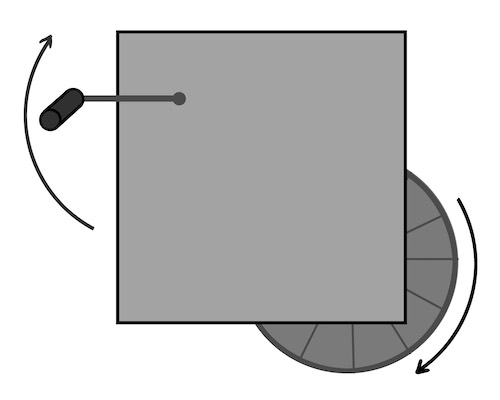4 of the best Ideas from The Idea Muse
Information overload is real, and attention is a limited valuable resource.
One year ago, I started the Idea Muse, a weekly newsletter sharing one idea: the best of what I’ve read and learned all week.
It’s beautiful when ideas read at different times come together, clicking, creating this connected web of knowledge.
To celebrate the anniversary, here’s 4 of my favourite timeless links to explore.
Anatomy for beginners
Edit: Looks like the videos have been removed - here’s the wiki page for the series
Imagine a box full of gears - you can’t see whats inside, but there’s a handle on one side, and a gear on the other side. When you move the handle clockwise, the gear moves clockwise, too.

Image via Sisi Chen
Now, you’re given a new box. Can you predict which way the gear will move?
Probably not. What you see is the behaviour. What you need is the placement of all the gears inside. That’s how you can predict the direction. This is the gears vs behaviour distinction.
How well do you know the human body? This series on anatomy explores a real human body from the inside. It blew my mind away - a gears level introduction to the body.
When you see the gears, you can make concrete predictions. You turn the black box transparent. Authority doesn’t mean much, once you have the gears.1
Reinventing explanation
Can a tool help you think better? A new map is a new lens to look at things.
Language is a tool we invented. Without language, we would’ve been stuck in a low bandwidth communication! Much like other animals today.
Writing is another tool we invented. Without writing, we couldn’t pass on all the information we captured. Every generation would start from scratch.2
Reinventing explanation is a lens. A demonstration of how we shouldn’t stop at writing. Writing was invented 5,000 years ago. Ever since, we’ve improved the medium. From rock carvings to clay to slate to paper to digital. How do we figure out the next tool?
Going Critical
When you create a map, a tool for thought, that’s isomorphic to another tool you know well, you can use all the results from that tool in your new lens.
This requires two things: figuring out the isomorphism, and knowing that a tool exists on the other side.
Going Critical explains the isomorphism between graphs and groups of people, ideas, looking at conditions necessary for them to go viral.
This is Network Theory.
Why are cities a cultural hub compared to villages? Why is Silicon Valley the hub for tech? Why fashion takes root in high school students and not parents?
After reading this, if you figure this doesn’t matter to you personally, consider how your life is driven by network effects.
Your life is a network, too. You’re more likely to be friends with someone you see everyday but mildly dislike, rather than someone you mildly like, who is far away. The effect compounds.
Harry Potter and the Methods of Rationality
Not everything is analytical, nor is everything solved by intuition. Focusing on just one is leaving a lot on the table. This is one reason the rational vs emotional and intuitive debate drives me crazy: you can have to choose both!
Imagine you’re a content marketer, writing a new blog post that you want to go viral. You begin by studying this article that went pretty viral. It has an interesting headline that makes you click on it. It starts out with an expletive - an introduction that hooks people in. It’s something everyone can relate to. It says smart stuff.
So, you come up with a list of things you need to go viral:
- Write an interesting headline that makes other people click
- Write an introduction that hooks people in
- Write something everyone can relate to
- Write smart stuff
You feel you’ve done well for the day. A productive research day - now you know exactly what you have to write.
… except, you have no idea how the fuck you’re supposed to write this.
Some things, like investigating a network of people and figuring out what an “idea” needs to go viral, is an explicit model - you can follow the math to get the properties of the idea. You can see examples and understand what they do well.
But, how do you come up with the “idea” with those properties? That’s more of a soft-skill. There’s no explicit model, and experts aren’t always able to explain how they came up with it. “Write something everyone can relate to” - you’ll usually find out if that’s true after you’ve published - and that’s too late.
This is where I’ve found newfound appreciation for fiction. Stories aren’t stories to the brain. Philosophy talks about why people have an emotional response to fiction, and lots of other ideas around how real it feels - without being real.
While I don’t care too much about why it happens, the fact that it does offers a way to learn soft skills: read fiction, and simulate what you would do in Harry Potter’s place.
HPMOR is one book that does it well for rationality - it covers all the big ideas from rationality I’ve found repeatedly useful.
And if you notice, I’ve done exactly this in the post - use examples to explain a deeper idea. Every link points out a connection between the idea I’m talking about and the rest of the web.

-
Of course, this doesn’t mean watching the videos will give you enough information to become a doctor yourself. The human body is vastly complex! Don’t confuse expertise with authority. ↩
-
Except what would get codified in their culture. They can’t preserve everything with language, but they can preserve the important to survival things. ↩
You might also like
- How to setup duration based profiling in Sentry
- How to simulate a broken database connection for testing in Django
- The "People fuck up because they're not like me" Fallacy
- How I Own Projects as a Software Engineer
